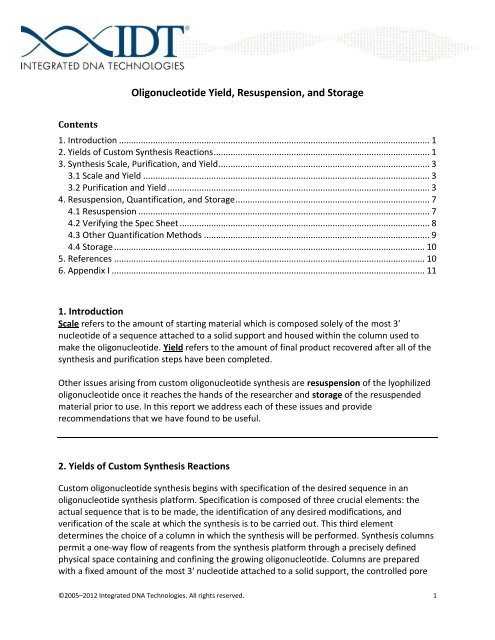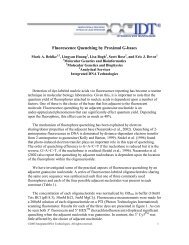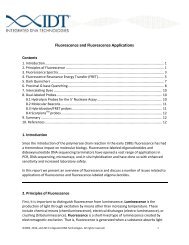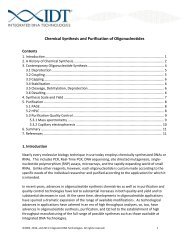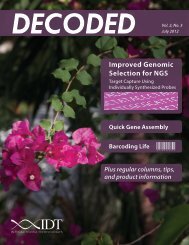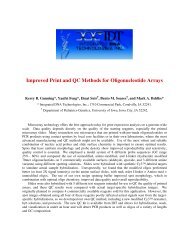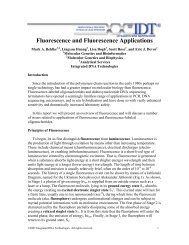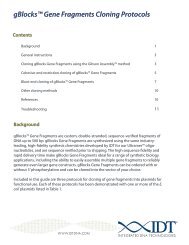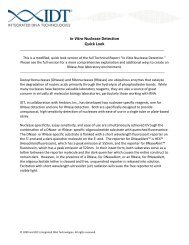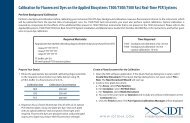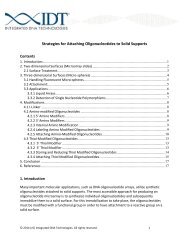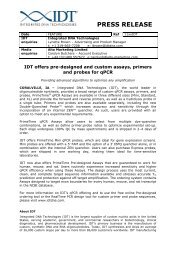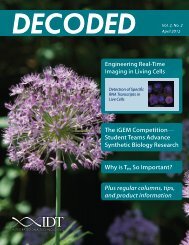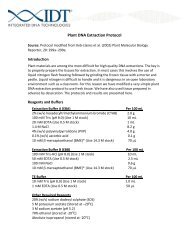Oligonucleotide Yield, Resuspension, and Storage - Integrated DNA ...
Oligonucleotide Yield, Resuspension, and Storage - Integrated DNA ...
Oligonucleotide Yield, Resuspension, and Storage - Integrated DNA ...
You also want an ePaper? Increase the reach of your titles
YUMPU automatically turns print PDFs into web optimized ePapers that Google loves.
<strong>Oligonucleotide</strong> <strong>Yield</strong>, <strong>Resuspension</strong>, <strong>and</strong> <strong>Storage</strong><br />
Contents<br />
1. Introduction ................................................................................................................................ 1<br />
2. <strong>Yield</strong>s of Custom Synthesis Reactions ......................................................................................... 1<br />
3. Synthesis Scale, Purification, <strong>and</strong> <strong>Yield</strong> ....................................................................................... 3<br />
3.1 Scale <strong>and</strong> <strong>Yield</strong> ...................................................................................................................... 3<br />
3.2 Purification <strong>and</strong> <strong>Yield</strong> ............................................................................................................ 3<br />
4. <strong>Resuspension</strong>, Quantification, <strong>and</strong> <strong>Storage</strong> ................................................................................ 7<br />
4.1 <strong>Resuspension</strong> ........................................................................................................................ 7<br />
4.2 Verifying the Spec Sheet ....................................................................................................... 8<br />
4.3 Other Quantification Methods ............................................................................................. 9<br />
4.4 <strong>Storage</strong> ................................................................................................................................ 10<br />
5. References ................................................................................................................................ 10<br />
6. Appendix I ................................................................................................................................. 11<br />
1. Introduction<br />
Scale refers to the amount of starting material which is composed solely of the most 3′<br />
nucleotide of a sequence attached to a solid support <strong>and</strong> housed within the column used to<br />
make the oligonucleotide. <strong>Yield</strong> refers to the amount of final product recovered after all of the<br />
synthesis <strong>and</strong> purification steps have been completed.<br />
Other issues arising from custom oligonucleotide synthesis are resuspension of the lyophilized<br />
oligonucleotide once it reaches the h<strong>and</strong>s of the researcher <strong>and</strong> storage of the resuspended<br />
material prior to use. In this report we address each of these issues <strong>and</strong> provide<br />
recommendations that we have found to be useful.<br />
2. <strong>Yield</strong>s of Custom Synthesis Reactions<br />
Custom oligonucleotide synthesis begins with specification of the desired sequence in an<br />
oligonucleotide synthesis platform. Specification is composed of three crucial elements: the<br />
actual sequence that is to be made, the identification of any desired modifications, <strong>and</strong><br />
verification of the scale at which the synthesis is to be carried out. This third element<br />
determines the choice of a column in which the synthesis will be performed. Synthesis columns<br />
permit a one-way flow of reagents from the synthesis platform through a precisely defined<br />
physical space containing <strong>and</strong> confining the growing oligonucleotide. Columns are prepared<br />
with a fixed amount of the most 3′ nucleotide attached to a solid support, the controlled pore<br />
©2005–2012 <strong>Integrated</strong> <strong>DNA</strong> Technologies. All rights reserved. 1
glass (CPG) bead. It is the amount of the most 3′ nucleotide present in the column, in<br />
nanomoles, that constitutes the synthesis scale.<br />
Once the column is properly prepared with the correct 3′ nucleotide at the desired scale, it is<br />
placed in the synthesis platform <strong>and</strong> the rest of the oligonucleotide is synthesized by adding<br />
each base of the specified sequence one at a time in the 3′→5′ direction. Because of chemical<br />
<strong>and</strong> physical restraints, the coupling efficiency is less than 100% at each step in the synthesis. In<br />
addition, coupling efficiency varies for each base both by type <strong>and</strong> position in the growing<br />
oligonucleotide [1, 2]. Experience gained at <strong>Integrated</strong> <strong>DNA</strong> Technologies from the synthesis of<br />
millions of oligonucleotides shows that some sequences will result in better yields than others.<br />
For example, one 24mer may give twice the yield of another 24mer even if they are synthesized<br />
on the same machine, the same day, <strong>and</strong> with the same reagents. Another source of yield<br />
variation can be the specific machine on which the synthesis is carried out. For this reason,<br />
<strong>Integrated</strong> <strong>DNA</strong> Technologies maintains a rigorous maintenance <strong>and</strong> monitoring program<br />
designed to keep each synthesis platform functioning at peak efficiency at all times.<br />
Even with the variables of custom oligonucleotide synthesis, it is possible to derive a theoretical<br />
yield for any given synthesis. Making the operational assumption that coupling efficiency for<br />
each nucleotide will be constant regardless of type <strong>and</strong> location, theoretical yield is given as,<br />
Y = (eff) n-1<br />
where (eff) is the average coupling efficiency <strong>and</strong> n is the number of bases in the<br />
oligonucleotide. Monitoring efforts at <strong>Integrated</strong> <strong>DNA</strong> Technologies confirm that our average<br />
coupling efficiency exceeds 99% for all oligonucleotides. Thus, theoretical yield for a 24mer will<br />
be 89.1% full-length product (FLP) at 99.5% average coupling efficiency <strong>and</strong> 79.4% FLP at 99.0%<br />
average coupling efficiency. A<br />
more complete picture of the<br />
relationship between coupling<br />
efficiency <strong>and</strong> %FLP for<br />
oligonucleotides of various<br />
lengths is shown in Figure 1.<br />
Two aspects of this relationship<br />
are readily apparent. First, the<br />
cumulative effect of even a<br />
0.5% average coupling failure<br />
rate can be dramatic for longer<br />
oligonucleotides. Second, minor<br />
increases in average coupling<br />
failure rates will have a<br />
substantial net effect on even<br />
average length<br />
oligonucleotides. It is for this<br />
Figure 1. Relationship between average coupling efficiency <strong>and</strong><br />
synthesis yield (Y = (eff) n-1 ) over a range of oligonucleotide lengths.<br />
©2005–2012 <strong>Integrated</strong> <strong>DNA</strong> Technologies. All rights reserved. 2
eason that <strong>Integrated</strong> <strong>DNA</strong> Technologies maintains constant, real-time monitoring of every<br />
custom synthesis reaction on every synthesis platform.<br />
3. Synthesis Scale, Purification, <strong>and</strong> <strong>Yield</strong><br />
3.1 Scale <strong>and</strong> <strong>Yield</strong><br />
<strong>Integrated</strong> <strong>DNA</strong> Technologies routinely offers yield guarantees based upon a combination of<br />
oligonucleotide length <strong>and</strong> synthesis scale. These guarantees are shown in Table 1. Synthesis of<br />
very long oligonucleotides (those greater than 60 bases) is problematic. Thus, <strong>Integrated</strong> <strong>DNA</strong><br />
Technologies does not offer any yield guarantees for oligonucleotides greater than 60 bases at<br />
our highest synthesis scale <strong>and</strong> greater than 100 bases at any scale.<br />
Table 1<br />
<strong>Yield</strong> Guarantees (in Optical Density Units; ODs) by Synthesis Scale<br />
Length<br />
Unmodified, Desalted<br />
Scale<br />
25 nmol 100 nmol 250 nmol 1 µmol<br />
5–9 5 10<br />
10–14 2 5 15<br />
15–19 3 4 19 30<br />
20–60 3 6 15 45<br />
61–80 6 15 45<br />
81–100 15 45<br />
Modifications can affect yield; please contact Customer Care for<br />
yield on specific modified oligonucleotides (800-328-2661) or<br />
custcare@idtdna.com<br />
3.2 Purification <strong>and</strong> <strong>Yield</strong><br />
As a general rule, IDT recommends that any oligonucleotide longer than 40 bases should<br />
receive further purification. In addition, for dem<strong>and</strong>ing applications such as site-directed<br />
mutagenesis, cloning, <strong>and</strong> gel-shift protein-binding assays, additional purification is<br />
recommended even for oligonucleotides shorter than 40 bases. Our experience has shown that<br />
taking the time to purify an oligonucleotide used in the more dem<strong>and</strong>ing applications saves far<br />
more in terms of the precious commodities of time <strong>and</strong> research funds than it costs on the<br />
front end. Thus, additional purification should be considered for any oligonucleotide that is to<br />
be used for any application other than routine PCR or <strong>DNA</strong> sequencing.<br />
©2005–2012 <strong>Integrated</strong> <strong>DNA</strong> Technologies. All rights reserved. 3
IDT offers preparative-scale purification via denaturing polyacrylamide/urea gels (PAGE) <strong>and</strong><br />
HPLC. While both of these methods will result in greatly increased oligonucleotide purity, one<br />
approach to purification may be superior to the other depending upon the intended use of the<br />
oligonucleotide <strong>and</strong> the presence or absence of modifications. A summary of general<br />
recommendations is presented in Table 2 below. Please note that additional purification will<br />
result in a decrease in final oligonucleotide yield. <strong>Yield</strong> guarantees for various combinations of<br />
synthesis scale <strong>and</strong> purification are presented in Table 3.<br />
Table 2<br />
General <strong>Oligonucleotide</strong> Purification Recommendations<br />
Basis of<br />
Purification:<br />
Mass Recovery<br />
(estimated):<br />
Pros<br />
Cons<br />
Recommendation<br />
PAGE<br />
Purification Method<br />
IE-HPLC*<br />
RP-HPLC*<br />
Length Hydrophobicity Length<br />
20–50% 40–70% 30–60%<br />
Best method to<br />
enrich the proportion<br />
of full-length product<br />
Only for syntheses ≤<br />
1 µmole<br />
Use for any<br />
oligonucleotide ≥ 50<br />
bases<br />
Best method for<br />
oligonucleotides with a<br />
hydrophobic group<br />
Does not remove (n-1)-mers<br />
very efficiently<br />
Use for oligonucleotides ≤ 50<br />
bases if intended for:<br />
- Site directed mutagenesis<br />
- Cloning, screening<br />
- Gel shift assays<br />
Good means of<br />
purifying large scale<br />
syntheses (≥10 µmole)<br />
Not good for<br />
oligonucleotides ≥ 80<br />
bases<br />
Use for large scale<br />
syntheses <strong>and</strong> for in<br />
vivo applications<br />
Use with any oligonucleotide<br />
modified with a hydrophobic<br />
group; i.e., Biotin, Digoxigenin,<br />
NHS-ester conjugates,<br />
Fluorescent dyes<br />
*RP-HPLC (reverse-phase), IE-HPLC (ion-exchange)<br />
©2005–2012 <strong>Integrated</strong> <strong>DNA</strong> Technologies. All rights reserved. 4
Table 3<br />
<strong>Yield</strong> Guarantees (in Optical Density Units; ODs) by Synthesis Scale <strong>and</strong> Method of<br />
Purification. Note that these guarantees refer to unmodified oligonucleotides<br />
Unmodified, HPLC-purified<br />
Length<br />
Scale<br />
25 nmol 100 nmol 250 nmol 1 µmol<br />
5–9 2 2.5<br />
10–14 1 3 5<br />
15–19 1 4 10<br />
20–60 1 4 20<br />
61–65 1 4 20<br />
66–70 1 3 15<br />
71–75 1 3 15<br />
76–80 1 2 10<br />
81–100 2 10<br />
Unmodified, PAGE-purified<br />
Length<br />
Scale<br />
25 nmol 100 nmol 250 nmol 1 µmol<br />
5–9 0 1.3<br />
10–14 0.5 1 2.5<br />
15–19 0.5 1.5 5<br />
20–50 1 2 10<br />
51–60 0.5 2 10<br />
61–65 0.5 2 10<br />
66–70 0.5 1.5 7.5<br />
71–75 0.5 1.5 7.5<br />
76–80 0.5 1 5<br />
81–100 1 5<br />
Modifications can affect yield; please contact Customer Care for<br />
yield on specific modified oligonucleotides (800-328-2661) or<br />
custcare@idtdna.com<br />
In specific instances, IDT requires additional purification of an oligonucleotide synthesis. One of<br />
these is any oligonucleotide of any length that is modified with phosphorothioate intended for<br />
use as an anti-sense agent. The impurities resulting from phosphorothioate syntheses are toxic<br />
in tissue culture as well as in in vivo applications. Other circumstances in which IDT requires<br />
additional purification of an oligonucleotide synthesis are presented in Table 4 below. Also<br />
presented in Table 4 are circumstances for which we strongly recommend additional<br />
purification<br />
©2005–2012 <strong>Integrated</strong> <strong>DNA</strong> Technologies. All rights reserved. 5
Purification<br />
Is<br />
Required<br />
Table 4<br />
IDT Purification Requirements <strong>and</strong> Recommendations<br />
5′ Modifications Internal Modifications 3′ Modifications<br />
Biotin dT<br />
Biotin-TEG<br />
Dual Biotin<br />
Fluorescein dT<br />
I-Linker<br />
5-Br dU<br />
*Bodipy ® 630/650-X<br />
*Bodipy ® 650/665<br />
Cy3<br />
Cy5<br />
Cy5.5<br />
2,6,-Diaminopurine<br />
Digoxigenin NHS<br />
JOE NHS<br />
*Oregon Green 488-X<br />
*Oregon Green 514<br />
*Rhodamine Green-X<br />
*Rhodamine Red-X<br />
ROX NHS<br />
TAMRA NHS<br />
Texas Red-X NHS<br />
Biotin dT<br />
Fluorescein dT<br />
5-Br dU<br />
*Bodipy® 630/650-X<br />
*Bodipy® 650/665<br />
2,6,-Diaminopurine<br />
JOE NHS<br />
*Oregon Green 488-X<br />
*Oregon Green 514<br />
*Rhodamine Green-X<br />
*Rhodamine Red-X<br />
ROX NHS<br />
TAMRA NHS<br />
Texas Red-X NHS<br />
Biotin-TEG<br />
Dabcyl<br />
*Bodipy® 630/650-X<br />
*Bodipy® 650/665<br />
Cy3 CPG<br />
Cy5 CPG<br />
Cy5.5 CPG<br />
Digoxigenin NHS<br />
JOE NHS<br />
*Oregon Green 488-X<br />
*Oregon Green 514<br />
*Rhodamine Green-X<br />
*Rhodamine Red-X<br />
ROX NHS<br />
TAMRA CPG/NHS<br />
Texas Red-X NHS<br />
Purification<br />
Is<br />
Optional<br />
Acrydite<br />
Amino C6<br />
Amino C12<br />
Amino dT<br />
2-Aminopurine<br />
Biotin<br />
C3 Spacer<br />
dSpacer<br />
6-FAM<br />
HEX<br />
Inosine<br />
5-Me-dC<br />
5-Nitroindole<br />
Phosphate<br />
Spacer 18<br />
TET<br />
Thiol C6<br />
Uridine<br />
Uni-Link Amino<br />
Amino dT<br />
2-Aminopurine<br />
C3 Spacer<br />
dSpacer<br />
Inosine<br />
5-Me-dC<br />
5-Nitroindole<br />
Spacer 18<br />
Uridine<br />
* NHS ester dye from Molecular Probes, Inc.<br />
Amino C7<br />
Biotin<br />
Dideoxycytidine<br />
6-FAM<br />
Inosine<br />
Inverted dT<br />
Phosphate<br />
3' Ribo Bases<br />
Thiol C3<br />
Uridine<br />
©2005–2012 <strong>Integrated</strong> <strong>DNA</strong> Technologies. All rights reserved. 6
4. <strong>Resuspension</strong>, Quantification, <strong>and</strong> <strong>Storage</strong><br />
4.1 <strong>Resuspension</strong><br />
<strong>Oligonucleotide</strong>s are shipped in dry (lyophilized) form unless otherwise requested. Dried <strong>DNA</strong> is<br />
usually very easy to resuspend in an aqueous solution. However, not all oligonucleotides dry<br />
identically <strong>and</strong> some can take a bit more time to completely go into solution than others. In<br />
addition, if the oligonucleotide solution freezes during the dry-down process in the Speed-Vac it<br />
will appear as a white powder similar in appearance to a piece of tissue or a kimwipe. In such<br />
cases it is possible for the dried oligonucleotide to become dislodged from the tube during<br />
shipping. Thus, it is very important to spin every oligonucleotide prior to opening the tube for<br />
resuspension.<br />
We recommend using TE buffer (10 mM Tris pH 8.0; 0.1 mM EDTA; pH 8.0) because the buffer<br />
will maintain a constant pH. The oligo should not be exposed to conditions that are either too<br />
acidic or too basic. Alternative, sterile water can be used for resuspending dry oligonucleotides.<br />
If using water for resuspension, be sure to use only nuclease-free water, pH 7.0 (HPLC-grade is<br />
preferable). DEPC water will harm oligonucleotides <strong>and</strong> water from deionizing systems can be<br />
acidic with pH as low as 5.0.<br />
<strong>Oligonucleotide</strong>s should be aliquoted into portions for immediate use <strong>and</strong> those for longer term<br />
storage in order to avoid contamination. Stock concentrations can be made using the yield<br />
information contained on the “spec sheet.” There you will find the actual yield of the<br />
oligonucleotide synthesis in three forms: optical density (OD) units; mass in milligrams (mg);<br />
<strong>and</strong> copy number in nanomoles (nm). We routinely resuspend dry oligonucleotides to a storage<br />
stock of 100 μM <strong>and</strong> then dilute working stocks accordingly. Adding TE or water at ten times<br />
the number of nanomoles will give a 100 μM final concentration. This concentration provides<br />
100 pmoles of oligonucleotide per μL. Most PCR reactions will use 10 to 50 pmoles of each<br />
primer per reaction.<br />
To make a 100 M concentration: Take the number of nmoles of oligo in the tube <strong>and</strong> multiply<br />
that by 10. This number will be the number of L of buffer to add to get a 100M solution. For<br />
example, if you have 9 nmoles of oligo, add 90 L of buffer to make a 100 M solution.<br />
For those researchers who prefer to work in mass units, the amount of oligonucleotide present<br />
in each tube in OD units <strong>and</strong> weight can be used. A 20mer oligonucleotide primer with r<strong>and</strong>om<br />
base composition will have a molecular weight of ~6100 <strong>and</strong> a molar extinction coefficient of<br />
196900 L/mole-cm. 1 OD 260 unit of this oligonucleotide will therefore correspond to 31 μg, or<br />
5 nmoles, of <strong>DNA</strong>. Dissolving 500 μg of <strong>DNA</strong> (16 OD units) in 500 μL of TE will yield a stock<br />
primer concentration of 1 μg/μL, or about a 160 μM solution. This converts to 160 pmoles of<br />
oligonucleotide per μL. Most PCR reactions set up using mass units will use about 60 ng of each<br />
primer. Working stocks should be set up accordingly. A dilution calculator is also available in<br />
SciTools on the IDT website.<br />
©2005–2012 <strong>Integrated</strong> <strong>DNA</strong> Technologies. All rights reserved. 7
An oligo can be stored at any concentration. However, concentrations lower than 1 µM may<br />
change over time as some of the oligo may be absorbed into the plastic of the tube. In addition,<br />
a 5–10 mM solution is generally the highest concentration at which an oligo will go into<br />
solution.<br />
For hard to suspend oligos, heat the oligo at 55 o C for 1–5 minutes, then thoroughly vortex. If<br />
this does not work, the tube might have Trityl (flakey appearance) or CPG (a pellet at bottom of<br />
tube). Neither of these should affect the performance of the oligo, <strong>and</strong> both can be removed<br />
with a Sephadex G50 column, or by removing the supernatant.<br />
4.2 Verifying the Spec Sheet<br />
The heterocyclic ring structures in <strong>DNA</strong> <strong>and</strong> RNA absorb light with a maximum absorbance near<br />
260 nanometers (nm). The most accurate means of assessing the amount of oligonucleotide<br />
present following synthesis is to measure the optical density of the final product at 260 nm.<br />
This value is provided on the spec sheet <strong>and</strong> it is determined only after purification since<br />
unincorporated nucleotides <strong>and</strong> protecting groups can lead to inaccurate estimates of<br />
oligonucleotide mass.<br />
While an estimate of mass will suffice for many applications in which oligonucleotides are used,<br />
it may be desirable for the researcher to verify mass after receiving the synthesis. One OD 260<br />
unit is defined as the amount of oligonucleotide which, when resuspended in a volume of<br />
1.0 mL, results in an absorbance of 1.0 when measured at 260 nm in a 1 cm path-length quartz<br />
cuvette. Once an oligonucleotide is resuspended according to the data provided on the spec<br />
sheet, replicate samples can be measured in a spectrophotometer at 260 nm <strong>and</strong> the mass<br />
amount can be calculated using the molar extinction coefficient, ε.<br />
The relationship between measured OD 260 , molar extinction coefficient (ε 260 ), <strong>and</strong><br />
oligonucleotide concentration is given as,<br />
OD 260 = ε 260 * Concentration<br />
Molar extinction coefficient is a unique physical property of every oligonucleotide determined<br />
by the sequence. Purine nucleotides will absorb more strongly than pyrimidine nucleotides<br />
regardless of whether they occur in <strong>DNA</strong> or RNA. ε 260 values for both <strong>DNA</strong> <strong>and</strong> RNA nucleotides<br />
are,<br />
dA = 15,400, dC = 7,400, dG = 11,500, dT = 8,700<br />
rA = 15,400, rC = 7,200, rG = 11,500, rU = 9,900<br />
in L/mole-cm [3, 4].<br />
However, interactions between neighboring bases alter absorbance in the same manner as<br />
such neighbor effect will alter the melting temperature (T m ) of <strong>DNA</strong>:<strong>DNA</strong> <strong>and</strong> RNA:<strong>DNA</strong> bases<br />
pairing. Thus, extinction coefficient is ultimately determined both by base composition <strong>and</strong><br />
©2005–2012 <strong>Integrated</strong> <strong>DNA</strong> Technologies. All rights reserved. 8
ase order. Taking base stacking interactions into account, nearest-neighbor values for ε 260<br />
among dinucleotides are;<br />
5′→3′ dA dC dG dT<br />
dA 27,400 21,200 25,000 22,800<br />
dC 21,200 14,600 18,000 15,200<br />
dG 25,200 17,600 21,600 20,000<br />
dT 23,400 16,200 19,000 16,800<br />
5′→3′ rA rC rG rU<br />
rA 27,400 21,000 25,000 24,000<br />
rC 21,000 14,200 17,800 16,200<br />
rG 25,200 17,400 21,600 21,200<br />
rU 24,600 17,200 20,000 19,600<br />
again, in L/mole-cm [5]. In general, then, calculation of the extinction coefficient of an<br />
oligonucleotide of length n can be given by the expression,<br />
1 2<br />
ε 260 = ∑ (ε nearest neighbor ) – ∑ (ε individual ) (1)<br />
n–1 n–1<br />
where the second term is a necessary correction for internal bases being counted more than<br />
once when nearest-neighbor doublets are summed. A numerical example of this calculation is<br />
presented in Appendix I.<br />
Finally, oligonucleotide modifications such as fluorescent dyes increase OD 260 absorbance<br />
values. When calculating extinction coefficients for modified oligonucleotides, it is important to<br />
use values for OD 260 <strong>and</strong> not the maximum absorbance of the modification. Correct molar<br />
extinction coefficients for any modified or unmodified oligonucleotide can be obtained using<br />
the on-line OligoAnalyzer 3.0 tool available in SciTools on the IDT website.<br />
4.3 Other Quantification Methods<br />
As noted, the most reliable means of determining oligonucleotide mass <strong>and</strong> concentration is to<br />
use OD 260 . However, such estimates can also be obtained by running oligonucleotides against<br />
known mass st<strong>and</strong>ards on polyacrylamide gels. The best results will be achieved using<br />
denaturing urea-based gels (7 M urea, 1X TBE) as these gels will, for the most part, eliminate<br />
the problem of secondary structure formation. <strong>DNA</strong> b<strong>and</strong>s can be visualized using UV<br />
backshadowing against a TLC plate where the <strong>DNA</strong> will appear as dark b<strong>and</strong>s against a light<br />
background. At <strong>Integrated</strong> <strong>DNA</strong> Technologies we examine every oligonucleotide synthesis at<br />
the 250 nmole scale or larger using this method. While it is a reasonably reliable method, UV<br />
visualization on polyacrylamide gels does require a substantial amount of the synthesis<br />
(5–6 mg) which is non-recoverable.<br />
©2005–2012 <strong>Integrated</strong> <strong>DNA</strong> Technologies. All rights reserved. 9
Agarose gels electrophoresis with ethidium bromide visualization is not a reliable method for<br />
quantifying oligonucleotides because ethidium bromide is an intercalating agent requiring<br />
double-str<strong>and</strong>ed structures. This means that only oligonucleotides having secondary structures<br />
can be visualized while those that do not form secondary structures are unable to provide a<br />
target for ethidium bromide intercalation.<br />
Finally, there are other fluorescent dyes that will bind to <strong>DNA</strong> but most of them, like ethidium<br />
bromide are useful only against double-str<strong>and</strong>ed substrates. Some dyes, like OliGreen <strong>and</strong> SYBR<br />
Green II will preferentially bind single-str<strong>and</strong>ed species but the fluorescence they produce is<br />
not directly quantitative. In order to produce even reasonable quantification using these<br />
reagents, they must be run against known masses so that a set of st<strong>and</strong>ard curves can be<br />
produced for comparison.<br />
4.4 <strong>Storage</strong><br />
Store resuspended oligonucleotides in several small aliquots at –20°C.<br />
5. References<br />
1. Temsamani J, Kubert M, <strong>and</strong> Agrawal S. (1995) Sequence identity of the n-1 product of a<br />
synthetic oligonucleotide. Nucleic Acids Res, 23(11): 18411844.<br />
2. Hecker KH <strong>and</strong> Rill RL. (1998) Error analysis of chemically synthesized polynucleotides.<br />
Biotechniques, 24(2): 256260.<br />
3. Cantor CR, Warshaw MM, <strong>and</strong> Shapiro H. (1970) <strong>Oligonucleotide</strong> interactions. 3. Circular<br />
dichroism studies of the conformation of deoxyoligonucleotides. Biopolymers, 9(9):<br />
10591077.<br />
4. Warshaw MM <strong>and</strong> Cantor CR. (1970) <strong>Oligonucleotide</strong> interactions. IV. Conformational<br />
differences between deoxy- <strong>and</strong> ribodinucleoside phosphates. Biopolymers, 9(9):<br />
10791103.<br />
5. Warshaw MM <strong>and</strong> Tinoco I Jr. (1966) Optical properties of sixteen dinucleoside<br />
phosphates. J Mol Biol, 20(1): 2938.<br />
©2005–2012 <strong>Integrated</strong> <strong>DNA</strong> Technologies. All rights reserved. 10
6. Appendix I<br />
A Numerical Example of the Molar Extinction Coefficient<br />
As an example of the method IDT uses to calculate the molar extinction coefficient, consider<br />
the M13 forward sequencing primer (–20). The sequence is:<br />
5′–GTA AAA CGA CGG CCA GTG–3′<br />
Applying equation 1 with the empirically derived ε 260 values shown in the text, we see that,<br />
260 = ( GT + TA + AA + AA + AA + AC + CG + GA + AC + CG + GG + GC + CC +<br />
CA + AG + GT + TG ) – ( T + A + A + A + A + C + G + A + C + G + G + C + C + A + G + T )<br />
260 = (20,000 + 23,400 + 27,400 + 27,400 +27,400 + 21,200 + 18,000<br />
+ 25,200 + 21,200 + 18,000 + 21,600 + 17,600 + 14,600 + 21,200<br />
+ 25,000 + 20,000 + 19,000) – (8,700 + 15,400 + 15,400 + 15,400<br />
+ 15,400 + 7,400 + 11,500 + 15,400 + 7,400 + 11,500 + 11,500<br />
+ 7,400 + 7,400 + 15,400 + 11,500 + 8,700)<br />
= (368,000) – (185,400) = 182,600<br />
Knowing this value <strong>and</strong> the total number of OD 260 units from the synthesis, the total number of<br />
molecules present (in millimoles) can be derived. If, for example, there are 16.1 OD 260 units<br />
from a synthesis of the M13 (–20), then,<br />
16.1 / 182,600 = 0.00008817 mmoles = 88.17 nmoles.<br />
Finally, knowing the number of molecules <strong>and</strong> the molecular weight of the oligonucleotide will<br />
provide the total weight, in milligrams, of the synthesis. The M13 (–20) weighs 5557.7 g/mole.<br />
Thus,<br />
(0.00008817) (5557.7) = 0.49002722 mg = 490.03 g<br />
These values, accounting for minor rounding errors, are what are provided by OligoAnalyzer 3.0<br />
available on-line in IDT SciTools if the M13 (–20) sequence is entered.<br />
©2005–2012 <strong>Integrated</strong> <strong>DNA</strong> Technologies. All rights reserved. 11


